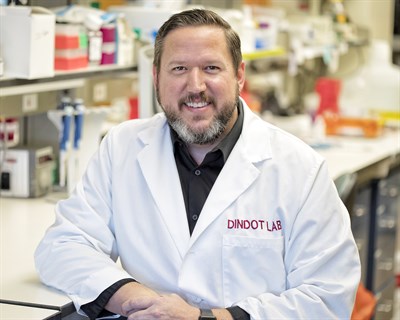Angelman Syndrome Treatment Being Investigated
Research from the laboratory of Texas A&M College of Veterinary Medicine & Biomedical Sciences (CVM) associate professor Scott Dindot has become the basis for an investigational antisense drug that researchers hope will lead to the treatment of Angelman syndrome (AS).
Investigational-new-drug-enabling studies on the potential therapeutic are currently underway with GeneTx Biotherapeutics LLC (GeneTx), a new biotech launched last week by the FAST (Foundation for Angelman Syndrome Therapeutics).

“This is a new area of medicine, known as a targeted therapy. Historically, clinicians have treated symptoms (of a disease) with medication but not the cause of the condition,” Dindot said. “A targeted therapy goes after the cause of the condition and attempts to fix it in some way. The drug we developed is called an antisense oligonucleotide, which is a synthetic molecule of DNA that binds to a gene and alters the way it is regulated.
“There are a few drugs that have been developed like this,” he said. “The drug is synthesized, and it looks like DNA but it’s not DNA.”
A rare genetic disorder that affects approximately one in 15,000 live births, AS is caused by a loss of function of the maternally inherited UBE3A gene. Symptoms of AS include developmental delay, impaired motor function, loss of speech, and epilepsy.
“Individuals with Angelman syndrome do not make the UBE3A protein in their brain because their father’s copy (of the gene) is turned ‘off’ by a naturally occurring phenomenon called genomic imprinting-we don’t know why this happens, but it occurs in everyone-and because they have a mutation on the copy inherited from their mother, which leaves them with no UBE3A protein in the neurons of their brain,” Dindot said. “The drug works by turning on the copy of the UBE3A gene inherited from the father.”
Dindot said this type of therapy has implications for other genetic disorders.
“First you have to know what gene is causing the condition, and then, depending on the type of mutation, you can use this technology to manipulate the way the gene is regulated,” he said. “FAST has been funding my lab to understand the way the father’s copy of UBE3A is turned off and why; we invested a lot of time and energy in understanding how this process works.
“While we are still trying to understand it, we discovered something that we thought was important, and we thought that it would be a good target for this drug,” he said. “We designed a drug to the target, and all of our preliminary studies indicate it’s a good target.”
Depending on the outcomes of the investigational new-drug-enabling studies, the hope is to move the drug into a Phase I Clinical Trial.
“This approach has been shown by other labs to be effective; it improves some of the core symptoms of the disorder in a mouse model of AS,” Dindot said.
Owned, in part by Texas A&M University, GeneTx entered into a worldwide license agreement with The Texas A&M University System and a research collaboration agreement with Texas A&M AgriLife Research in hopes of further developing and commercializing this product.
“The launch of GeneTx is the logical next step in FAST’s mission to cure Angelman syndrome,” said Paula Evans, FAST chairperson and GeneTx CEO. “We want to ensure potential treatments for AS are brought to each patient as safely and expeditiously as possible, and being actively involved in the interim process between bench and bedside ensures we will have a strong voice in the pricing and accessibility of possible treatments for Angelman families worldwide.”
“For the past eight years, FAST has narrowly focused on investing in leading-edge technologies to treat the underlying cause and debilitating symptoms of Angelman syndrome,” said Allyson Berent, FAST CSO and GeneTx COO. “Our aggressive research agenda and collaboration with Texas A&M AgriLife Research has identified and characterized a promising therapeutic to address this debilitating syndrome. Angelman syndrome has such a significant unmet need, for which there are no approved therapeutics, and the landscape for bringing meaningful treatments to the community is significantly expanding.”


